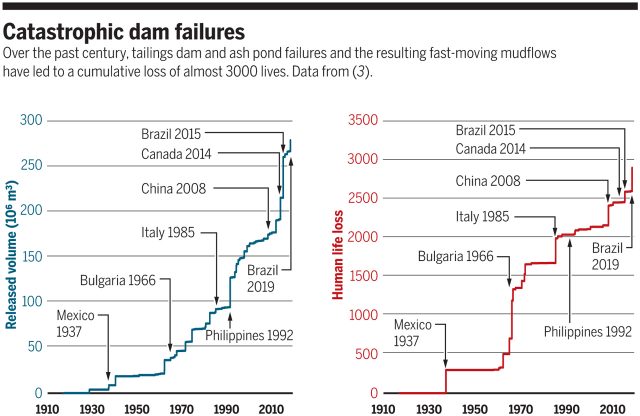13 May 2019
Tailings dam failures: an interesting perspective article in Science
Posted by Dave Petley
Tailings dam failures: an interesting perspective article in Science
Late last week the journal Science published a very interesting Perspective article (Santamarina et al. 2019) on tailings dam failures. The gist of the article is summarised in this part of the conclusion:
“Given the number of tailings and ash impoundments around the world and their historical failure rate, more failures can be anticipated. The situation is aggravated by the tragic consequences often faced by the populations living downstream from the impoundment. Each incident prompts us to gain better physical insight, improve engineering practices, and implement regulations to minimize the potential for future catastrophes.”
It argues that given the number of tailings facilities worldwide (over 9000), there is an urgent need to gain a better understanding of the mechanisms of tailings dam failures, and to use this understanding to improve management practices. The urgency of this problem is illustrated by this diagram, from the article, showing volumes released, and losses of life, from tailings dam failures (with data from the fantastic World Mine Tailings Failures site):-

Losses from tailings dam failures, showing cumulative released volume and resulting loss of life. From Santamarina et al. (2019) via Science.
.
The article makes a couple of really interesting points. The first is that there is increasing evidence that our understanding of the failure mechanisms of tailings may be imperfect. In particular the Brumadinho failure challenges the concept that tailings stability increases with time, given that it had been decommissioned three years before the collapse. They suggest that a part of this might be the challenges in replicating in the laboratory processes that occur in real conditions over years or even decades. Santamarina et al. (2019) suggest that fly ash, for example, might undergo chemical changes shortly after deposition that leads to the grains becoming cemented together, preserving high porosity. This makes the material brittle and prone to collapse, inducing liquefaction.
But second, despite this imperfect understanding, Santamarina et al. (2019) note that most tailings dam failures are the result of poor management and regulation. They note for example that:
“At Brumadinho, the filling of the tailings dam appears to have proceeded without clear tailings disposal guidelines between 1976 and 2005, a departure from sound engineering practice.”
I have highlighted before the unacceptable rate of tailings dam failures. This article calls for a twin track approach of research to understand failure mechanisms (noting of course that translation of that knowledge into practice is essential, but not always simple) and improved management / regulation. It is hard to argue against that conclusion.
Reference
Santamarina, JC., Torres-Cruz, L.A. and Bachus, R.C. 2019. Why coal ash and tailings dam disasters occur. Science, 364 [6440], 526-528. DOI: 10.1126/science.aax1927


 Dave Petley is the Vice-Chancellor of the University of Hull in the United Kingdom. His blog provides commentary and analysis of landslide events occurring worldwide, including the landslides themselves, latest research, and conferences and meetings.
Dave Petley is the Vice-Chancellor of the University of Hull in the United Kingdom. His blog provides commentary and analysis of landslide events occurring worldwide, including the landslides themselves, latest research, and conferences and meetings.
Enough recent tailing dam failures that an impending one in Cacaos (sp?) Brazil reached BBC TV News ‘teletext’ 17/5/19. Happily, the motion has been sufficiently slow for ‘at risk’ zone to be evacuated some weeks ago.
Such do have a nasty habit of unexpected entrainment, run-out etc so Be Not There…
🙁
One area that should be of concern is just who is doing the field investigations for these dams. In my experience many firms use young civil geotechnical engineers who lack geological training and experience. Combine this with civil designers who also lack geologic training and the odds of failure are significantly increased.